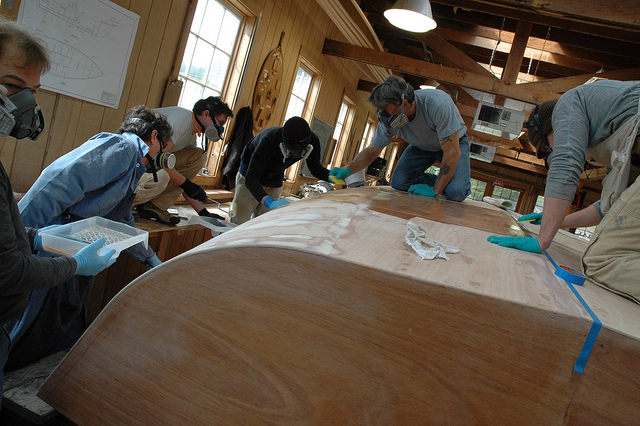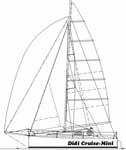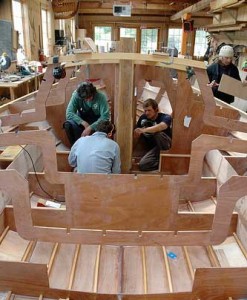
Dix Cruise-Mini takes shape at the Boat School
From David Blessing
It can be hard to give up some of the things we enjoyed when we were younger. Sometimes these things need to be translated into terms that meet our present situation. Some years ago I loved high speed sailing on my 505 in the summer on Chesapeake Bay. From time to time, I would have to swim alongside the capsized the boat to get the thing back under control. With warm water, this was not a problem.  Now I live in Puget Sound country where the prospect of landing in the water is not as pleasant. I would still like to sail a fast boat and be able to go sailing with a small crew.
Now I live in Puget Sound country where the prospect of landing in the water is not as pleasant. I would still like to sail a fast boat and be able to go sailing with a small crew.
So I decided to build the Didi Cruise-Mini designed by Dudley Dix. The hull of this boat is derived from his Mini Transat ocean racing design, but he toned the rig down a bit and included some concessions to provide rudimentary accommodations below decks. The hull is 21 feet overall and is quite beamy. There is a lifting daggerboard in a trunk with an 880 pound bulb at the bottom. There is a large asymmetrical spinnaker set on an articulating bowsprit that should ensure lively performance off the wind. The Northwest School of Wooden Boatbuilding built most of the boat and did a beautiful job of it.
 The hull is constructed of okoume sheet plywood and West System epoxy, with a cold molded portion at the chine. The plywood is laid over sawn plywood frames and longitudinal stringers, giving a very light stiff structure (but an admittedly cluttered interior). Construction is light and depends on structural fillets and glass tape to hold it together.
The hull is constructed of okoume sheet plywood and West System epoxy, with a cold molded portion at the chine. The plywood is laid over sawn plywood frames and longitudinal stringers, giving a very light stiff structure (but an admittedly cluttered interior). Construction is light and depends on structural fillets and glass tape to hold it together.
I am l often asked about a launch date but I confess I don’t know. There is still a lot of work to do to complete it . Sometime this fall, I hope.
So what do I want to do with this boat? It is capable of crossing oceans, but I don’t plan to do that. It would be a mighty rough ride in heavy weather; it is designed for speed, not comfort. If a design is not required to be seakindly in all conditions, then it can be a lot more fun to sail in reasonable conditions, which, after all, are the norm around here anyway.
Any boatbuilding project can be a considerable undertaking and it is easy to underestimate the commitment in time and money required. There is a lot of satisfaction that comes out of such a project. The support and patient instruction I have experienced from the Northwest School of Wooden Boatbuilding has made this project a thorough joy—to be matched, I anticipate, from the sailing. Look for me out in the Bay this fall. I’ll be the guy in the yellow boat with the big grin.
We heard from David last week that the bottom paint is going on and the mini is moving out of the Boat School to make room for next semester’s projects. A slide show of the mini’s construction is available here on The Northwest School of Wooden Boatbuilding’s Flickr site which was the source of the photos used in this post. The drawing of the Mini-Cruise is from Dix’s site.